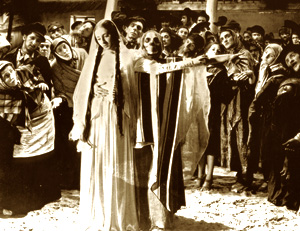The creature of the black lagoon was characterized as the epitome of terror. This film gave life to a magnificent monster. Many of his physical features are meant to intimidate and pester people. Even the movie ads portray a monster that looks dangerous and repulsive. This monster originates from the amazons and is a combination of human and fish. His extremities are covered by scales, and he is able to agilely swim and walk. The success of this monster was mostly because many of the 50’s Sci-Fi films began to make use of various side effects.



What is particularly surprising is that aside from the fact the monster displays a physically dangerous appearance all of the movies present a creature that is mellow. It is somewhat ironic to see the monster in the ads as a scary monster, yet the first movie is about a creature that falls in love with a member of the explorer team. The second movie, The Revenge of the Creature (1955) exhibits him as a powerless being that is mistreated while in captivity. Lastly the movie entitled, The Creature Walks Among Us (1956) makes of this monster a fragile creature that is old and hurt, desperate to be sent back to its natural habitat. All of these movies, instead of making the creature of the Black Lagoon appear as the monster, they make humans appear as the real heartless individuals who show no remorse in mistreating and vilely exhibiting a poor creature as if he were the worst creation in the world. Nevertheless, the “scaring” effect this monster produced resulted in innumerable copies and remakes of this character. In my point of view this creature is anything but a monster; he clearly exhibits very human-like qualities such as vulnerability, compassion, love and fear. Yet, during the time period the movie was aired the monster was detested and scary. This drives me to think whether movie industries attempt to display the image of a typical monster only by means of disturbing physical characteristics, after all that was the only thing scary of this monster.

 Religion in its essence is a medium by which individuals seek comfort and security. Its principles are supposed to serve as a framework in which ethical foundations are set. The benign aspects of religion can be numerous, however, religion is free from defects. Religion can easily diverge into its dark side which consists of cults, extremist, demonic possessions, and witchcraft. Folktales in particular, play an eminent role in disclosing the dark sides especially those that deal with demonic possessions A Jewish folktale for example, whose roots are trace back to the old testament of the Bible, revolves around a spirit known as Dybbuk. This spirit is known to linger in the world of the living because it is unable to rest in peace due to the sins it committed in the past. The lamenting soul would then cling itself into the body of an individual. By doing so, it completely takes possession over the body and its actions, with the only purpose of torturing the being it took over. It must be taken into consideration that this spirit, according to the folktale, is only able to take over a body of a sinner or someone who is not spiritual. The immense popularity over the concept of Dybbuk has enabled it to be adapted to the big screen by movies such as, The Possession, The Tenth Man, and The Unborn.
Religion in its essence is a medium by which individuals seek comfort and security. Its principles are supposed to serve as a framework in which ethical foundations are set. The benign aspects of religion can be numerous, however, religion is free from defects. Religion can easily diverge into its dark side which consists of cults, extremist, demonic possessions, and witchcraft. Folktales in particular, play an eminent role in disclosing the dark sides especially those that deal with demonic possessions A Jewish folktale for example, whose roots are trace back to the old testament of the Bible, revolves around a spirit known as Dybbuk. This spirit is known to linger in the world of the living because it is unable to rest in peace due to the sins it committed in the past. The lamenting soul would then cling itself into the body of an individual. By doing so, it completely takes possession over the body and its actions, with the only purpose of torturing the being it took over. It must be taken into consideration that this spirit, according to the folktale, is only able to take over a body of a sinner or someone who is not spiritual. The immense popularity over the concept of Dybbuk has enabled it to be adapted to the big screen by movies such as, The Possession, The Tenth Man, and The Unborn.
